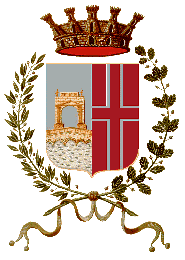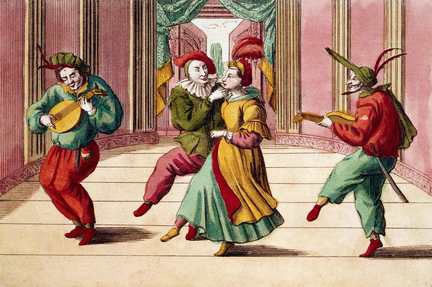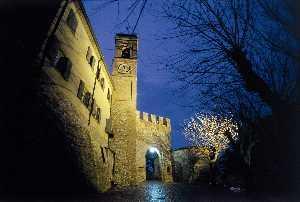Symbols of the Municipality of Rimini
Coat of arms
The Municipality of Rimini adopt one bipartite shield:
- First half: on a background silvery (upper) and a rippling sea (lower), theAugustus Arch and the Tiberius Bridgerepresented in an ideal reconstruction of their original appearance.
- Second halfof colour red, presents a guelph cross red edged in silver.
The coat of arms, approved in 1930is the result of the union of two historical emblems:
- The symbol of the free medieval communeattested in some ancient seals.
- La guelph crossgranted to the city in 1509 by Pope Julius II with the 'sipontina bubble'.
The study for the creation of the Rimini herald was entrusted by the podestà to Carlo Lucchesi, administrator of the Gambalunghiana Library, who was inspired by the centuries-old local tradition. Two distinctive elements, the bridge and the arch, were already present in coats of arms from much earlier periods. Of these, the seal of Duke Orso, dating back to the 10th century A.D. and found in 1865, is particularly significant. This symbol was used alongside those of the Lombard League in the struggle against Frederick Barbarossa in 1167. Luigi Tonini, a scholar who dedicated extensive research to the coat of arms, elaborated on these considerations, although they have recently undergone critical revision.
As for the symbol of the cross, it has more recent origins: it was conferred in 1509 by Pope Julius II, after the expulsion of the Malatesta family. The cross, white and red, represented the colours of Rimini and sanctioned the restoration of the province's privileges, reconfirmed through the so-called 'Sipontina Bull'.
The municipal statutes of Rimini
The first drafting of the statutes of the municipality of Rimini dates back to 1334. However, the rules codified in them are rooted in much older customs and habits. The statutes were divided into three books:
- Roles of municipal magistrateswhich defined the tasks of the city authorities.
- Private law and citizens' dutieswith rules on civilised living.
- Regulation of administrative and economic activitiesinherent in the management of the municipality.
The Motto and Fascism
In the 1930s, during the Fascist regime, there was the idea of adding the motto 'Arimini Libertas' to the city's coat of arms. However, the proposal was rejected by the Heraldic Council for reasons that have never been fully clarified. As an alternative, the motto 'Jacta Est Alea' was approved in 1937, in homage to Julius Caesar's famous phrase and the prestigious past of Imperial Rome.
Honours
City Title
- Awarded 31 March 1930 by decree of Head of Government.
Gold Medal for Civilian Valour
Conferred by decree of the President of the Republic on 16 January 1961on the following grounds:
"Faithful to its noblest traditions, it stoically endured the most serious destruction of the war for liberation, attesting, with the heroic sacrifice of numerous of its sons, its purest faith in a better, free and democratic Italy."
- Rimini, 1940-1944
Ordinary uniform ribbons available for the decorated.










